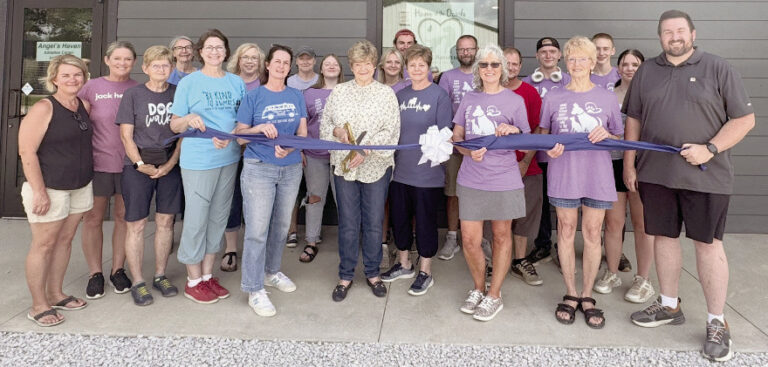Through the Years, Feb. 7

50 years ago
Feb. 13, 1974
— CHICAGOANS BUILDING ROLLER RINK AT KNOB
Construction is underway on a 40×100 foot structure on new Highway 39 just north of Shell Knob that will house a skating rink and recreation complex being developed by Mr. and Mrs. D. F. Murphy. The owners came to this area from Chicago, Illinois, last June. Scheduled for naming as Longview Rec, an opening will depend on the building process, which in turn will progress as weather permits. Murphy said this week the plans are to include other recreational features in addition to the roller rink. Year round operation is scheduled by the builders. Footings for the metal building were being poured during good construction weather this week. The commercial venture is the first north of Shell Knob off the new highway. Murphy, who was formerly associated with a paper binding firm, said the recreation center would be easily accessible to the entire recreation area of Table Rock Lake and Roaring River State Park.
— AMBULANCE PROBLEMS PILE HIGH FOR SOUTH COUNTY
Ambulance services to this area got a double dose of difficulty this week when LeRoy Rouse, operator of the program since October indicated he would resign February 25 and stumbling blocks for the formation of an ambulance district appeared. Taking the first to occur under consideration, the South Barry County Emergency Rescue Service, Inc., began looking for possibilities of a replacement and an early solution for the district formation. Cherry Warren, group president, said there were several possibilities for both problems. Rouse, who has been operating as a private individual the last four months, listed lack of cooperation from the people and financial reasons for his returning to a hospital post in Sedalia. One of the two units Rouse has been using, belongs to the emergency rescue corporation and will be retained by the group. Warren, who had hoped for an early formation of an ambulance district to obtain additional revenue, said he would meet with other officials this week. Included in this group are: Bob Mitchell, vice-president; Steve Burch, secretary- treasurer; and directors Gene Taggart, Don Peterson and Mayor Bill LeCompte. Tom Cardin, attorney for the group, met with Jim May, from the Missouri Regional Medical Program, this week and learned petitions must be circulated to form the district but will require 60 days after this task is accomplished to call a vote. This would rule out an April 2 vote during school elections to cut costs. Warren said the petition process would be initiated as soon as district boundaries were determined by the emergency service group. A district could levy a 15c tax levy that would provide about $25,000 annually toward service expenses and operation. The city of Cassville has made provisions to acquire equipment, valued at $30,000 at a cost of $7,000 local funds. This process too presents difficulties since a Wheaton operation must give approval before government grants can be accomplished. May said Lonnie Plumlee, operator of the service had agreed to his approval providing the Liberty and Wheaton townships are not included in the district. Plumlee and Wheaton area’s conditions must be met before Dr. John K. Wallace, director of the Bureau of Emergency Ambulance Services with the State Department of Health, will approve Cassville’s application for the vehicles that could be leased or sold to a newly formed district. May told Cardin and Warren this week the process following petition circulation to the County Court would be a 30 day period for public hearings and then another 30 days required before an election could be called. A simple majority of the vote cast could approve district formation. Being unable to call the election with regular school voting will require additional expenditure of funds for election officials. It will also delay a decision on the district. Warren hopes the emergency service corporation will be able to secure a new operator for the service prior to the cut-off date set by Rouse providing the services. Corporation plans had been to eliminate Wheaton township from any district plans but was not aware until Tuesday of further demands of Liberty being removed. Warren said it was possible that residents of this area might be presented petitions to determine their wishes in the matter. Basically, the district had been planned as follows, with township populations also included: Flat Creek 3,261, White Rivers 472, Shell Knob 230, Jenkins 306, McDonald 521, Mineral 631, Roaring River 380, Washburn 735, Sugar Creek 815, Ash 529, Exeter 993 and Butterfield 484. As quickly as the district boundaries are proposed, petitions will be placed in each for circulation toward obtaining a minimum of 10% signatures of the number of voters in the last election for governor. Emergency service corporation officials said this week they would welcome any: suggestions from residents of the area. Assistance in obtaining signatures would also be helpful in expediting the program, Warren said. The notfor- profit corporation got the ambulance problem dropped in their laps when private operators discontinued the emergency services last year. They were faced with federal and state regulations that made it difficult for them to continue private operations. Districts, such as is being proposed by the corporation, are being formed throughout Missouri for continued ambulance service to the people. Wheaton is heading in this direction according to May, with plans to include areas in McDonald and Newton counties in their district.
40 years ago
Feb. 15, 1984
— PROJECTS IN HIGHWAY BID CALL
Barry County and connecting area road projects are included in bids to be opened February 24, by the Missouri Highway and Transportation Department. Numbering 91 in all, the projects are expected to cost about $25.7 million. Direct Barry County projects include the following three: Missouri Route 97, a 20-ft. wide bituminous surface leveling course on one mile of Route 97 between the Lawrence County line and U.S. Route 60. Missouri Route 37 business route, a 22-foot wide bituminous surface leveling course at Cassville between Missouri Route 37 and Missouri Route 248. Missouri Route 76, a 22-foot wide bituminous surface leveling course on Route 76 beginning just east of Missouri Route 37 south of Cassville and extending easterly for approximately one half mile. A Lawrence County project includes a connection on Missouri Route 97, a 20-foot wide bituminous surface leveling course on approximately one mile, of Route 97 between Missouri Route 37 at Pierce City and the Barry County line. District Engineer Joseph Mickes had previously announced the city route improvement project during a session here with the Barry County Court. The project will include improvements in the Hankins Hill area north of town, in an area reassumed as state maintenance under agreement with the court. Acceptable bid proposals will mean work will be accomplished on the projects this summer.
— 63 DAIRY SIGN-UP IN BARRY COUNTY
Out of a total of 220 dairy farms in Barry County, 63 have been approved for programs designed to reduce milk production according to the ASCS office in Cassville. A total of 94 set bases for deadlines last month. Apparently 31 of these later chose not to participate in the program. State-wide, 1,813 dairy farms signed for the program out of a total of 11,500. In the nation, only about 12 percent of the total dairy production people signed up for the cut back. Federal officials termed the sign-up disappointing, since they had hoped a larger number would participate. “It appears the dairy surplus problem is not going to be resolved as quickly as we had hoped,” said one office. According to federally approved contracts in the nation, farmers plan to cull 336,796 cows from their herds under the program, most going to slaughter. Twentythree percent of the culling would be done by the end of January, with the remainder at the rate of about 20,000 head per month. As of January 1, there were about 11 million dairy cows in the nation. 1 Officials said, “this should not have a significant impact on cattle, poultry or hog markets” Livestock producers had been fearful that up to one million head of cows. or more would be sent to slaughter under the program, creating market problems.
30 years ago
Feb. 2, 1994
— U.S. POPULATION CENTER MOVING TOWARD SW AREA
A University of Missouri extension and industry specialist stationed in Taney County is predicting the center of population in the United States is “relentlessly closing in on Branson.” Now we’d expect that out of someone closely related to Branson, so don’t be too critical with Tom Keohan one of the Lakes Country specialists serving under extension’s regional concept. Keohan stated this week, “If the current shift in population continues its westward march, in the year 2000 Branson could very well be in the center.” Keohan, who works with business in that bustling tourism area, would naturally like to see this happen, it would create even more public attention to the fast growing entertainment center. But, there are those in the region of southwest Missouri who think the dip might not be that far south. In 1790, the first nose counting in the Census, Chesterfield, Md. was the center of population in these United States. Four years ago in the 1990 counting process, the center was near Steelville, Mo., which is in Crawford county, just south of Interstate 44. Assuming the trend in direction were to turn slightly further south than continuing in a southwest direction, Keohan might be correct in his assumptions. However, if the course were to stay more toward a southwesterly direction, who knows, the population center might get close to Barry County. “The population is growing faster than previously estimated. The U. S. Census Bureau projections suggest that the 1990s will witness dramatic growth, second only to the 1950s,” he says. Statistics show of the 114 counties comprising Missouri’s political subdivisions, 33 of the 44 counties north of the Missouri River lost residents in the decade 1980 to 1990. As the southwest region continues to grow, significant changes in school districts, legislative districts, job opportunities, retail sales and tax revenues will shape a different economy in Missouri, Koehan says. The Missouri of the future will be significantly different from the Missouri of the past. For example, population estimates show that 67 counties, including Barry, mostly south of the Missouri River gained residents since 1980. St. Louis and 49 counties lost population. All of the counties experiencing population losses had farming or mining-based economics, according to Koehan. “Missouri only gained a four percent increase in population from 1980 to 1990. If this low gain continues into 2000 this may cause a loss of congressional seat, something that Missouri cannot afford to give up,” he says. “Future funding for much-needed roads, for example, could be reduced along with other federally-funded projects,” the official noted. Says Koehan: Projections show that the population will grow to 276 million in 2000, 27 million more than the 1990 population. During the 1950s the population jumped by 28 million. As recently as 1992 the Census Bureau projected that the United States had a population of 253,572,641, already a 2-percent increase over the 1990 census count. It was projected to grow another 2.7 million during 1992. Demographers are now agreeing that this figure is on target with the presently projected population of 226 million.




